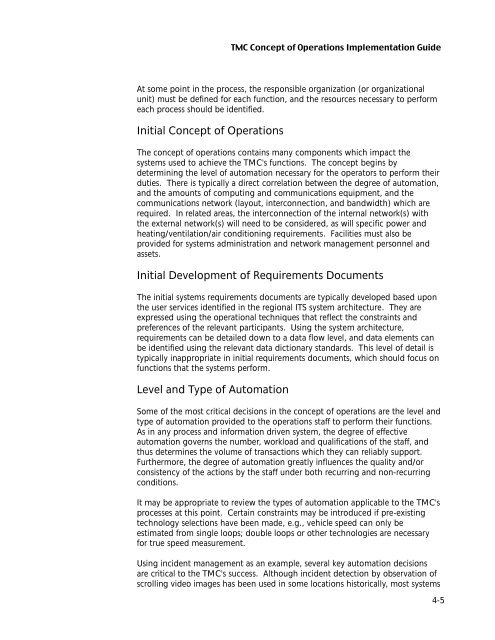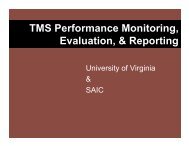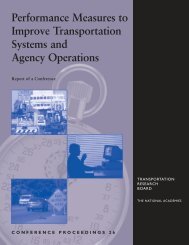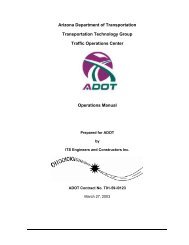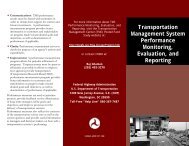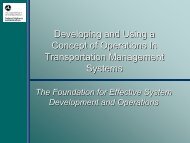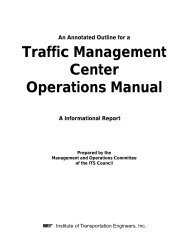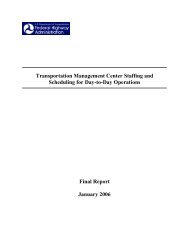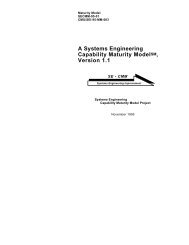Transportation Management Center Concepts of Operations
Transportation Management Center Concepts of Operations
Transportation Management Center Concepts of Operations
- No tags were found...
You also want an ePaper? Increase the reach of your titles
YUMPU automatically turns print PDFs into web optimized ePapers that Google loves.
At some point in the process, the responsible organization (or organizationalunit) must be defined for each function, and the resources necessary to performeach process should be identified.Initial Concept <strong>of</strong> <strong>Operations</strong>The concept <strong>of</strong> operations contains many components which impact thesystems used to achieve the TMC's functions. The concept begins bydetermining the level <strong>of</strong> automation necessary for the operators to perform theirduties. There is typically a direct correlation between the degree <strong>of</strong> automation,and the amounts <strong>of</strong> computing and communications equipment, and thecommunications network (layout, interconnection, and bandwidth) which arerequired. In related areas, the interconnection <strong>of</strong> the internal network(s) withthe external network(s) will need to be considered, as will specific power andheating/ventilation/air conditioning requirements. Facilities must also beprovided for systems administration and network management personnel andassets.Initial Development <strong>of</strong> Requirements DocumentsThe initial systems requirements documents are typically developed based uponthe user services identified in the regional ITS system architecture. They areexpressed using the operational techniques that reflect the constraints andpreferences <strong>of</strong> the relevant participants. Using the system architecture,requirements can be detailed down to a data flow level, and data elements canbe identified using the relevant data dictionary standards. This level <strong>of</strong> detail istypically inappropriate in initial requirements documents, which should focus onfunctions that the systems perform.Level and Type <strong>of</strong> AutomationSome <strong>of</strong> the most critical decisions in the concept <strong>of</strong> operations are the level andtype <strong>of</strong> automation provided to the operations staff to perform their functions.As in any process and information driven system, the degree <strong>of</strong> effectiveautomation governs the number, workload and qualifications <strong>of</strong> the staff, andthus determines the volume <strong>of</strong> transactions which they can reliably support.Furthermore, the degree <strong>of</strong> automation greatly influences the quality and/orconsistency <strong>of</strong> the actions by the staff under both recurring and non-recurringconditions.It may be appropriate to review the types <strong>of</strong> automation applicable to the TMC'sprocesses at this point. Certain constraints may be introduced if pre-existingtechnology selections have been made, e.g., vehicle speed can only beestimated from single loops; double loops or other technologies are necessaryfor true speed measurement.Using incident management as an example, several key automation decisionsare critical to the TMC's success. Although incident detection by observation <strong>of</strong>scrolling video images has been used in some locations historically, most systems4-5


